From the Trenches
The Case of the Missing Incisors
By SAMIR S. PATEL
Monday, August 11, 2014
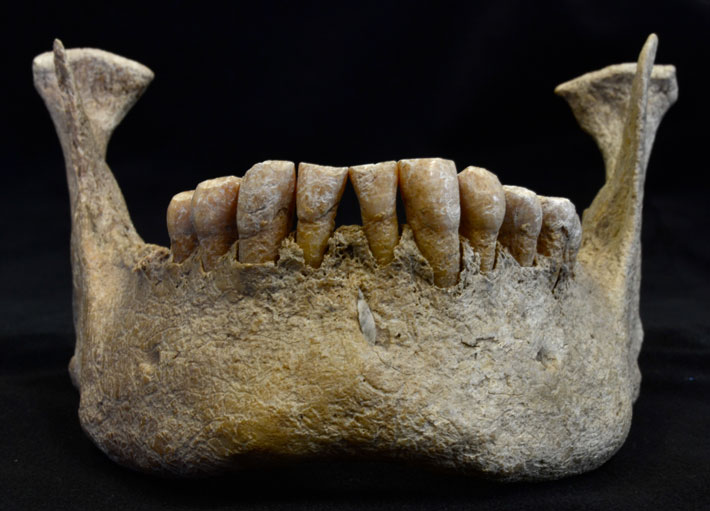 Bioarchaeologist Angela Lieverse of the University of Saskatchewan had long been fascinated by a specimen from the Baikal-Hokkaido Archaeology Project, which she has worked on since the late 1990s. It was a skull that had been excavated near Lake Baikal in Siberia in 1994, from a burial rather typical of the Early Bronze Age, around 4,000 years ago. The skull stood out because the lower jaw is missing the two central incisors, and the tip of a stone projectile point is embedded just below where the missing teeth should be. Had the teeth been knocked out by the blow? Lost to disease? Impacted in the jaw? Ritually removed?
Bioarchaeologist Angela Lieverse of the University of Saskatchewan had long been fascinated by a specimen from the Baikal-Hokkaido Archaeology Project, which she has worked on since the late 1990s. It was a skull that had been excavated near Lake Baikal in Siberia in 1994, from a burial rather typical of the Early Bronze Age, around 4,000 years ago. The skull stood out because the lower jaw is missing the two central incisors, and the tip of a stone projectile point is embedded just below where the missing teeth should be. Had the teeth been knocked out by the blow? Lost to disease? Impacted in the jaw? Ritually removed?
Lieverse and her colleagues used clinical CT and synchrotron radiation micro-CT at the university’s Canadian Light Source facility to solve the mystery. “The position of the projectile point was simply a coincidence,” she says, and the teeth hadn’t been removed. Rather, they had never been there at all. The scans show no partial teeth or space for the roots in the jaw, which points to agenesis of the mandibular incisors, a surpassingly rare genetic condition in which the teeth never form.
As for the projectile strike, which occurred at the time of death but likely wasn’t the cause, the scans were used to create a digital model of the tip and match it to the rest of the arrowhead, which was found in the man’s eye socket.
Dawn of a Disease
By SAMIR S. PATEL
Monday, August 11, 2014
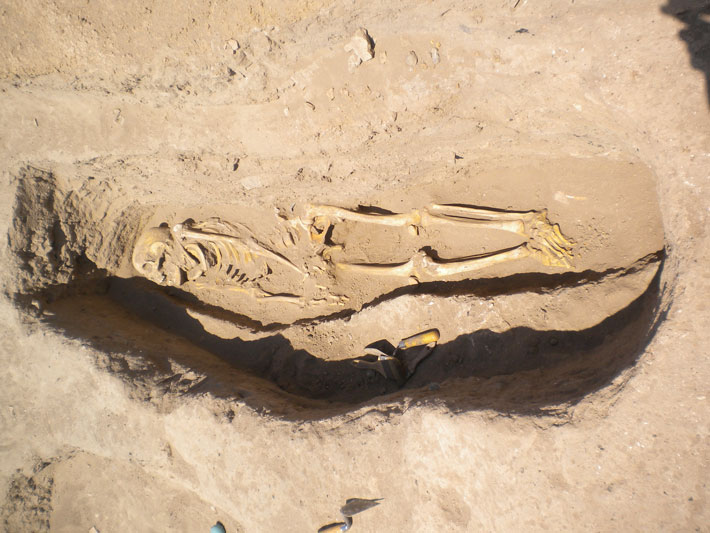
Schistosomiasis, a disease caused by parasitic flatworms, today infects some 250 million people worldwide, causing severe pain, anemia, and even death. Recent analysis of human skeletal remains from Tell Zeidan in northern Syria has revealed that these parasites have plagued humankind for thousands of years—enabled by the same human innovations that made the area habitable for large numbers of people. Soil from a burial there, dating to more than 6,000 years ago, contained the remains of a schistosome egg, the oldest known evidence of the disease by 1,000 years. Humans can contract the disease by wading in freshwater, where the snails that host the parasites live. People at Tell Zeidan farmed wheat and barley, which would not have been possible in the arid region without irrigation systems. It is these freshwater systems that the researchers believe allowed schistosomiasis to spread. “This discovery might be among the oldest evidence of man-made technology inadvertently causing disease outbreaks,” says study coauthor Piers Mitchell of the University of Cambridge.
The Dovedale Hoard
By JASON URBANUS
Monday, August 11, 2014
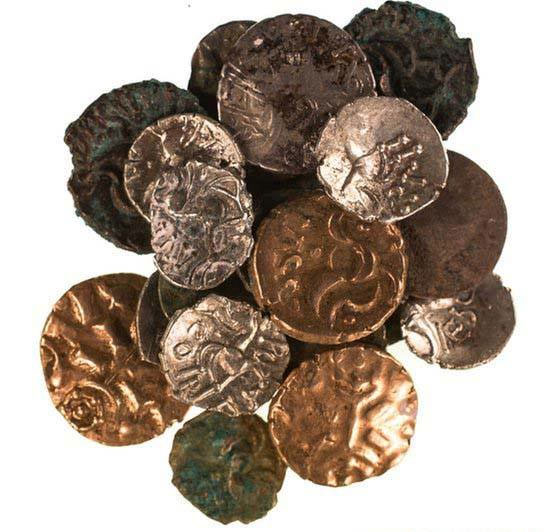 Archaeologists from Britain’s National Trust have unearthed a hoard of late Iron Age and Roman coins in Reynard’s Kitchen Cave in Dovedale, Derbyshire. The initial discovery of four coins was made by a local climber seeking shelter in the cave during a rainstorm. Archaeologists have since retrieved a total of 26 gold and silver coins, all of which predate the Roman invasion of Britain in a.d. 43. While the bulk of the hoard is attributed to the Iron Age Corieltavi tribe, at least three coins are of Roman origin—the first instance of coins from these two civilizations having been found buried together. The location of the hoard is also unexpected, explains National Trust archaeologist Rachael Hall. “Coin hoards of this era in Britain have been found in fields and other locations but, as far as we know, not in a cave,” she says. “We may never know why the coins were buried here, but this discovery adds a new layer to what we are learning about Late Iron Age activity.”
Archaeologists from Britain’s National Trust have unearthed a hoard of late Iron Age and Roman coins in Reynard’s Kitchen Cave in Dovedale, Derbyshire. The initial discovery of four coins was made by a local climber seeking shelter in the cave during a rainstorm. Archaeologists have since retrieved a total of 26 gold and silver coins, all of which predate the Roman invasion of Britain in a.d. 43. While the bulk of the hoard is attributed to the Iron Age Corieltavi tribe, at least three coins are of Roman origin—the first instance of coins from these two civilizations having been found buried together. The location of the hoard is also unexpected, explains National Trust archaeologist Rachael Hall. “Coin hoards of this era in Britain have been found in fields and other locations but, as far as we know, not in a cave,” she says. “We may never know why the coins were buried here, but this discovery adds a new layer to what we are learning about Late Iron Age activity.”
An Ancient Andean Homecoming
By ERIC A. POWELL
Monday, August 11, 2014
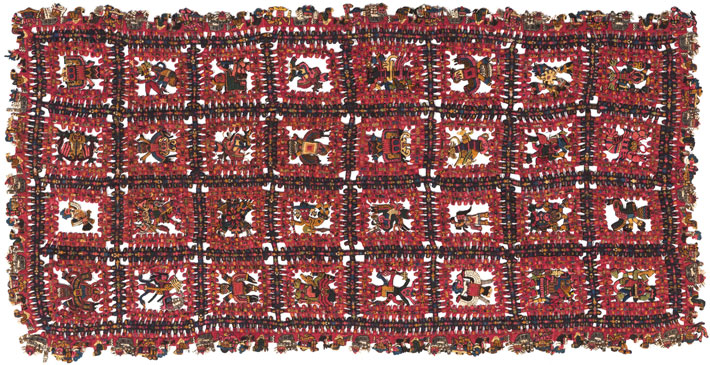
In the 1930s, a Swedish diplomat smuggled dozens of 2,000-year-old textiles out of Peru. Now the Swedish city of Gothenburg is returning the entire collection. The most spectacular example, known as the Shroud of Gothenburg, depicts a shaman flying through the air, animals as diverse as condors and shrimp, and crops such as corn, peanuts, and beans. Pontifical Catholic University of Peru archaeologist Krzysztof Makowski points out that figures on the edge of the piece seem to mark the 365 days of the solar year. “The decorations are our main source for decoding prehistoric Andean religious beliefs,” he says. “Textiles were the most technologically complex artifacts in Andean prehistory.”
Saving the Golden House
By MARCO MEROLA
Monday, August 11, 2014
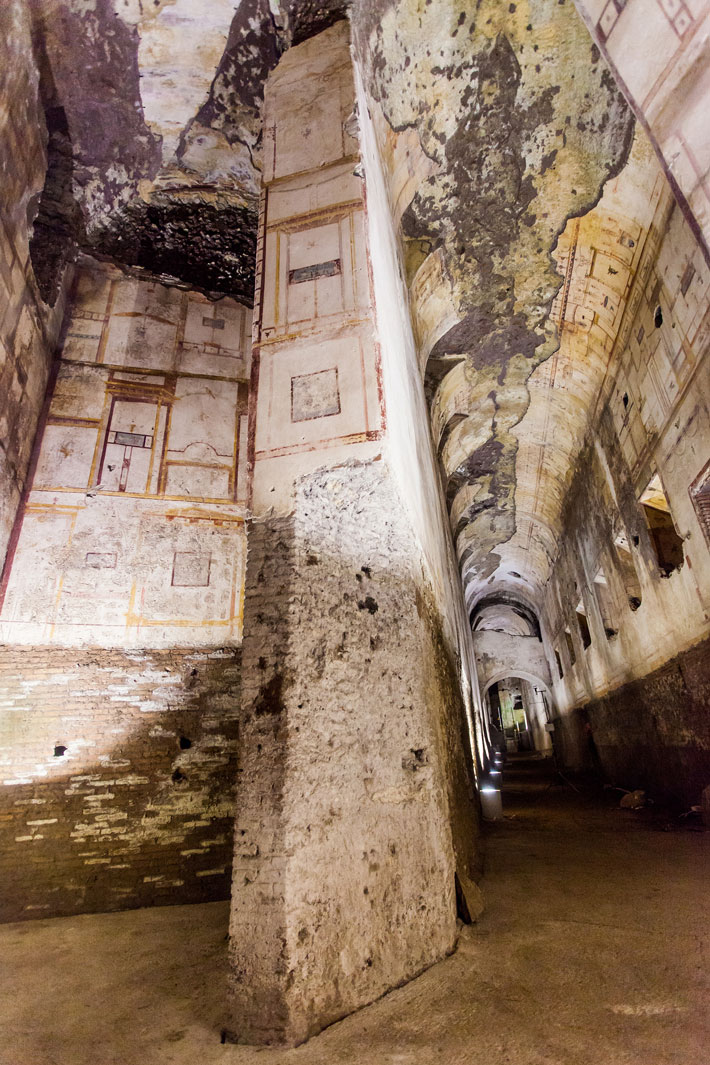 The Domus Aurea, or “Golden House,” is one of the most important monuments in Rome, but it is also at great risk. Built by the emperor Nero between A.D. 58 and 64, the staggering property in the heart of imperial Rome might have sprawled across as many as 300 acres, though its true extent is difficult to judge. The main villa of the complex has more than 300 rooms, including an octagonal dining room with a revolving domed roof, walls inlaid with jewels and gold, ceilings covered in mosaics, and brightly colored frescoes on nearly every wall and vaulted ceiling. But for all its splendor, the Domus Aurea has been closed since 2005 for safety reasons—and a ceiling vault collapsed in 2010. Persistent problems with drainage and moisture threaten both its structural stability and its decorations. Recently, the archaeological superintendency of Rome embarked on the last phase of an ambitious restoration project. “We hope,” says superintendent Mariarosaira Barbera, “that the Domus Aurea can be visited again by 2018, and that it will last another 2,000 years.”
The Domus Aurea, or “Golden House,” is one of the most important monuments in Rome, but it is also at great risk. Built by the emperor Nero between A.D. 58 and 64, the staggering property in the heart of imperial Rome might have sprawled across as many as 300 acres, though its true extent is difficult to judge. The main villa of the complex has more than 300 rooms, including an octagonal dining room with a revolving domed roof, walls inlaid with jewels and gold, ceilings covered in mosaics, and brightly colored frescoes on nearly every wall and vaulted ceiling. But for all its splendor, the Domus Aurea has been closed since 2005 for safety reasons—and a ceiling vault collapsed in 2010. Persistent problems with drainage and moisture threaten both its structural stability and its decorations. Recently, the archaeological superintendency of Rome embarked on the last phase of an ambitious restoration project. “We hope,” says superintendent Mariarosaira Barbera, “that the Domus Aurea can be visited again by 2018, and that it will last another 2,000 years.”
Advertisement
Advertisement
IN THIS ISSUE
From the Trenches
Your Face: Punching Bag or Spandrel?
Off the Grid
Sounds of the Age of Aquarius
Conquest and Clamshells
They're Just Like Us
Modern-Day Ruin
World's Oldest Pants
Off With Their Heads
Alone, but Closely Watched
Saving the Golden House
The Dovedale Hoard
An Ancient Andean Homecoming
Dawn of a Disease
The Case of the Missing Incisors
Advertisement

Recent Issues
-
 May/June 2024
May/June 2024
-
 March/April 2024
March/April 2024
-
 January/February 2024
January/February 2024
-
 November/December 2023
November/December 2023
-
 September/October 2023
September/October 2023
-
 July/August 2023
July/August 2023
-
 May/June 2023
May/June 2023
-
 March/April 2023
March/April 2023
-
 January/February 2023
January/February 2023
-
 November/December 2022
November/December 2022
-
 September/October 2022
September/October 2022
-
 July/August 2022
July/August 2022
-
 May/June 2022
May/June 2022
-
 March/April 2022
March/April 2022
-
 January/February 2022
January/February 2022
-
 November/December 2021
November/December 2021
-
 September/October 2021
September/October 2021
-
 July/August 2021
July/August 2021
-
 May/June 2021
May/June 2021
-
 March/April 2021
March/April 2021
-
 January/February 2021
January/February 2021
-
 November/December 2020
November/December 2020
-
 September/October 2020
September/October 2020
-
 July/August 2020
July/August 2020
-
 May/June 2020
May/June 2020
-
 March/April 2020
March/April 2020
-
 January/February 2020
January/February 2020
-
 November/December 2019
November/December 2019
-
 September/October 2019
September/October 2019
-
 July/August 2019
July/August 2019
-
 May/June 2019
May/June 2019
-
 March/April 2019
March/April 2019
-
 January/February 2019
January/February 2019
-
 November/December 2018
November/December 2018
-
 September/October 2018
September/October 2018
-
 July/August 2018
July/August 2018
-
 May/June 2018
May/June 2018
-
 March/April 2018
March/April 2018
-
 January/February 2018
January/February 2018
-
 November/December 2017
November/December 2017
-
 September/October 2017
September/October 2017
-
 July/August 2017
July/August 2017
-
 May/June 2017
May/June 2017
-
 March/April 2017
March/April 2017
-
 January/February 2017
January/February 2017
-
 November/December 2016
November/December 2016
-
 September/October 2016
September/October 2016
-
 July/August 2016
July/August 2016
-
 May/June 2016
May/June 2016
-
 March/April 2016
March/April 2016
-
 January/February 2016
January/February 2016
-
 November/December 2015
November/December 2015
-
 September/October 2015
September/October 2015
-
 July/August 2015
July/August 2015
-
 May/June 2015
May/June 2015
-
 March/April 2015
March/April 2015
-
 January/February 2015
January/February 2015
-
 November/December 2014
November/December 2014
-
 September/October 2014
September/October 2014
-
 July/August 2014
July/August 2014
-
 May/June 2014
May/June 2014
-
 March/April 2014
March/April 2014
-
 January/February 2014
January/February 2014
-
 November/December 2013
November/December 2013
-
 September/October 2013
September/October 2013
-
 July/August 2013
July/August 2013
-
 May/June 2013
May/June 2013
-
 March/April 2013
March/April 2013
-
 January/February 2013
January/February 2013
-
 November/December 2012
November/December 2012
-
 September/October 2012
September/October 2012
-
 July/August 2012
July/August 2012
-
 May/June 2012
May/June 2012
-
 March/April 2012
March/April 2012
-
 January/February 2012
January/February 2012
-
 November/December 2011
November/December 2011
-
 September/October 2011
September/October 2011
-
 July/August 2011
July/August 2011
-
 May/June 2011
May/June 2011
-
 March/April 2011
March/April 2011
-
 January/February 2011
January/February 2011
Advertisement






